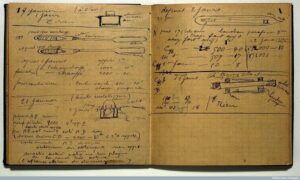Doctor Curmudgeon® The Mother of Modern Physics
By Diane Batshaw Eisman, M.D. FAAP Doctor Eisman is in Family Practice in Aventura, Florida with her partner, Dr. Eugene Eisman, an internist/cardiologist
“1903 Nobel Prize in Physics
1911 Nobel Prize in Chemistry
1921 Willard Gibbs Award (presented by the Chicago Section of the American Chemical Society)
1931 Cameron Prize for Therapeutics of the University of Edinburgh
“My dear child those are only a few of the honors bestowed upon Marie Curie. It was some time in 1891 that I heard her speak at a student gathering at the University of Paris. I had given a lecture the day before. Her questions were astonishingly insightful.
“After meeting this brilliant young woman I delayed my return to London. It was obvious that Marie was a brave soul, a pioneer on her way to breakthroughs in Science. I wanted to spend more time with her.”
My Great-Great-Great Grandmother, Dr. Cranky Wangshaw-Vesalius-Steinberger was a rare woman, who became a physician in that era. She was a half-sister to Dr. John Watson. And we all know of Dr. Watson who had a most eminent patient, Sherlock Holmes.
Grandma Cranky occasionally visits me, usually in the evening as I am preparing for bed.
Grandma Cranky continued, “Dr. Marie Salomea Sklodowska Curie received many accolades, awards and medals.
“You should be aware that Dr. Curie was first person to be honored with the Nobel Prize in two different fields, Chemistry and in Physics, and the first woman to receive a Nobel.”
After Grandma Cranky whisked away, I read more about this woman. Indeed, she was the “Mother of Modern Physics.”
In 1891 Marie went to Paris to study Chemistry, Physics and Mathematics at the University of Paris.
And it was in Paris, that she met a brilliant French physicist by the name of Pierre Curie.
Working together they discovered a new radioactive element. It was named polonium in honor of the country of Marie’s birth, Poland.
It was a short time later that the pair discovered radium.
A colleague of the Curies, Dr. Henri Becquerel had just discovered a fascinating new property that Marie later named ‘radioactivity.”
She was able to lay her hands on pure radium and did a Ph.D. on the study of radioactivity.
Finally! A woman was the recipient of a Nobel! In 1903, it was shared by Becquerel and the Curies for their discovery of radioactivity. Becquerel’s research led him to find that uranium spontaneously emitted some kind of rays, which could penetrate like X-rays.
In those days, nobody was aware of the dangers of radioactivity.
According to Barbara Tasch, who wrote in Business Insider, Bill Bryson penned in his wonderful book, “A Short History of Nearly Everything,” that Dr. Curie’s personal items, (such as her lab notes, furniture and clothing) are still radioactive.
Those intriguing lab notebooks ae stored in Pars at the Bibliotheque National in appropriately lead lined boxes.
And, if you really want to see those manuscripts, you must sign a waiver of liability and wear protective gear because they are all still contaminated with radium 226.
Marie Curie died of aplastic anemia, which is linked to her work with radioactive radium and polonium.
Even her body is still radioactive and lies in a lead-lined coffin.
Dr. Curmudgeon suggests “Bitter Medicine”, Dr. Eugene Eisman’s story of his experiences–from the humorous to the intense—as a young army doctor serving in the Vietnam War.
Bitter Medicine by Eugene H. Eisman, M.D. –on Amazon
Doctor Curmudgeon® is Diane Batshaw Eisman, M.D., a physician-satirist. This column originally appeared on SERMO, the leading global social network for doctors.
SERMO www.sermo.com
Click Here to Order Boxing Interviews Of A Lifetime By “Bad” Brad Berkwitt


